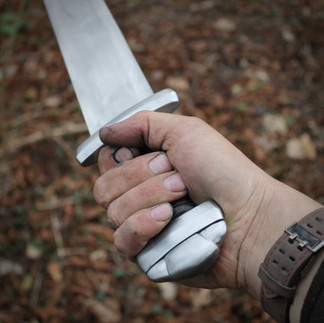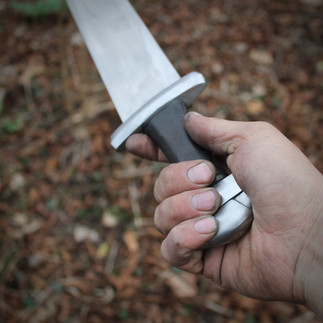The Linnmistar Viking Sword
- Alicia Adams
- Feb 27, 2023
- 2 min read
Updated: Feb 12, 2024

This imposing Viking sword is immediately notable for the breadth of its straight-tapered blade. An experiment in asymmetrical ergonomic elements as researched by Roland Warzecha, it features a tang offset, a gentle pommel twist, a gentle pommel cant, and pommel offset to preserve overall symmetry and sit comfortably in the right hand. Chris employed a number of traditional manufacturing techniques to create this sword, including forge-welding the guard around the tang, hot-forging the three-lobed pommel cap, and and brazing the pommel in the forge. The grip shape is inspired by surviving metal examples from the same era, and is of a historical length, which comes into its own when the pommel is resting in the palm. Drawing from Chris's experience with handling swords of the Viking age, the whole is deceptively light for such a broad-bladed weapon. Thanks to the ergonomics of the grip and pommel the sword feels nimble and lively in the hand, excelling in sweeping actions and swift thrusts. As with its original precedents, it would be in its element paired with a shield. This sword is named for a Skaldic kenning, literally meaning, "Serpent of the Mist". The term was used by poets as a descriptive stand-in for the word "sword" in 12th-century sagas. Please see our pricing structure for an idea of what a similar sword would cost.
∴ Specs ∴

Total length: 95cm
Blade length: 80cm
Blade width at shoulder: 6cm
Blade stock: 6mm
Quillon span: 9cm
Grip length: 9cm
Grip and pommel: 13cm
Point of balance: 17.5cm
Weight: 1060g
Right-handed
2mm blunt edges
Swollen tip
Fencing-safe flex
∴ Notes ∴

The hand-forged and heat-treated guard and pommel are polished to a satin finish.
The lenticular lower guard is faceted horizontally, while the matching upper guard features a three-lobed pommel cap. The pommel as a whole is twisted and canted for right-handed use, along with an offset tang and grip.
The oak grip is wrapped first in linen thread, and then in dark brown kidskin. The long, broad blade features a strikingly wide fuller. The construction is finished with a faceted copper peening block.
∴ Gallery ∴
∴ A Warrior's Rite∴

Light kisses morning mist
Miring the fighting field,
A silver, silken veil
Swathing a stubbled plain.
Half-drunk on distant drums
That punctuate the day,
You shrug your aching shape
Into shimmering maille.
Its weight hangs, heavy fate,
On shoulders hurt and cold,
Familiar and fain,
The form you now assume:
A serpent in reverse,
Not sloughing off dead skin,
But slipping into scales
Steadfast against the blade.
Half-laughing you heft
The handle of your sword,
Wrought by a fiery forge,
Flat-bladed, made for war.
Three-lobed, the pommel’s press,
Calming against your palm,
The sword extends the self:
The snake of battle wakes.
This poem is written in an approximation of the Skaldic metre used by the warrior poets of Medieval Scandinavia. This highly restrictive form calls for 8 lines of six syllables per verse, with verses in alliterative pairs, the first line of which contains two alliterative syllables. All lines must contain an instance of assonance.
Skaldic metre often acted as a form of encryption within its oral tradition, helping poets to recall the right words, and making it next to impossible for the text to be altered.


















